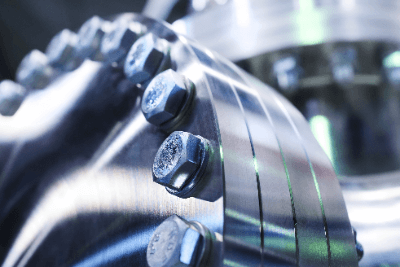What Is a Flange Bolt?

A flange bolt is a screw that can be inserted without a washer. They are called flange bolts because there is a flange attached to the bolt. The advantage is that it is difficult to loosen because it has a seat attached, and it eliminates the need to assemble a washer.
There are two types of flange bolts: Type 1 and Type 2, with Type 1 having a flat washer flange and Type 2 having a tapered flange top.
Uses of Flange Bolts
Flange bolts are used in a wide range of applications, from consumer products such as automobiles to industrial products, such as various types of manufacturing equipment. Since flange bolts have a larger seating surface than hexagonal bolts, they do not sink into the bolt hole to be fastened, thus improving the appearance of the bolt.
In addition, the incorporation of washers is not necessary, which improves work efficiency. Therefore, this type of bolt is used when a clean appearance is desired or when work efficiency is to be improved.
Principle of Flange Bolts
The head shape and height of flange bolts are often determined at the discretion of the manufacturer, and many varieties exist.
In the case of M6 bolts, both Type 1 and Type 2 have the same “seat diameter 14.0 mm – hexagonal head 10 mm – head height 6.0 mm” and differ only in the surface shape of the seat surface. In some manufacturers’ standards, the back side of the washer may be processed with serrations (serrations). The serration allows the washer to bite into the fastening object easily, thereby improving stability.
In most cases, steel or stainless steel is used as the material. However, depending on the surrounding environment, titanium may be used. By appropriately selecting from a wide variety of flange bolts, stable and efficient fastening can be achieved.
How to Use Flange Bolts
Incorrect use of flange bolts can result in damage to nuts and equipment to be fastened. To prevent this, the following points should be taken into consideration when using flange bolts.
- The fastening force must be within the allowable range.
- Repeated force (due to vibration, etc.) applied to the flange bolt must be within the allowable range.
- The pressure applied to the seating surface does not cause the fastening object to cave in.
- The fastening force of the flange bolt shall not damage the fastening object.
Other Information on Flange Bolts
1. Materials and Surface Treatments of Flange Bolts
Flange bolt materials include steel, stainless steel, and titanium. Since each material has different strengths, it is necessary to fully consider these materials at the equipment design stage.
Electrical corrosion is also an important factor. If the material of the flange bolts differs from the material of the object to be fastened, electrical corrosion will occur. Particular attention should be paid to the case of aluminum and stainless steel.
Surface treatments for flange bolts include copper plating, black paint, trivalent chromate, uni chromate plating, hot-dip zinc plating, chromate plating, nickel plating, chrome plating, Parker, and necrotized. As mentioned above, selection is made according to electric corrosion protection, appearance, etc.
2. How to Prevent Flange Bolts from Loosening
Flange bolts may loosen over time. If flange bolts loosen and come off, there is a risk of a serious accident involving human life. Loosening can be caused by the following two factors:
- Repeated vibration applied to the flange bolts
- The heat generated in the flange bolt from the ambient temperature or from the object to be fastened
Tightening flange bolts too hard has the effect of preventing loosening, but there is a danger of the flange bolts breaking or the threaded hole tearing. Therefore, it is important to calculate the allowable range of fastening force at the time of design.
When retightening is used to prevent loosening, the bolts should be tightened according to the specified torque. Other measures to prevent loosening rather than retightening include the use of anti-loosening adhesives and double nuts. Although there is no guarantee that a machine will never loosen, it is necessary to take measures to prevent loosening to ensure the safe use of the machine.